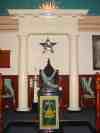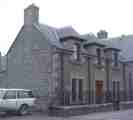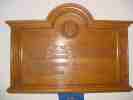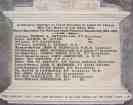 | Caithness.Org | Community | Business | Entertainment | Caithness... | Tourist Info | Site Map |
• Advertising • Chat Room • Contact Us • Kids Links • Links • Messageboard • News - Local & Scottish • News - UK & News Links • About / Contact Us • Submissions |
• Bookshop • Business Index & News • Jobs • Property For Sale • Property For Rent • Shop • Sutherland Business Index |
• Fishing • Fun Stuff • George, The Saga • Horses • Local Galas • Music • Pub Guide • Sport Index • What's On In Caithness |
• General Information • B & Bs • Backpackers • Caravan & Camping • Ferries • Getting Here • Holiday Letting • Hotels • Orkney • Pentland Firth • Sutherland • Taxis |
| N E W S F E E D S >>> |
Masonic Lodges
St Fergus Lodge - Wick
| Masonic Lodges Main Index | |
|
St Fergus Lodge Of Freemasons |
|
|
History
St. Fergus has had “four” meeting places since coming into existence. They first met in Brim’s Buildings (now the reception area and office of the Riverside Nursing Home) in which they rented two rooms from 1868 to 1872. They then found better accommodation in Union Street, also rented (where McKain & Sutherland, Upholsterers, traded) and held meetings there until 1890. During these periods there were only two halls available in the town - the Temperance Hall and the Artillery Hall. From the minutes of that time it states that these venues were on a “to let” basis, and were used by other organisations It can be safely assumed that Brims Buildings was the venue for the Lodge as from the first minutes consultation had to take place with a Mr Brims as to the charges for the use of the rooms. On 14 February 1870 it appeared that the premises were no longer suitable, discussion then took place to find more suitable premises. At the meeting of 13 November 1871 it was unanimously agreed to look for premises of their own. On 9 December 1872 it was agreed to rent a hall in Lower Pulteney, for 3 years, at a rent of �16 per annum. The current lease on Brims Buildings had expired. The R.W.M. reported that on examination they found it and the other apartment everything to be desired. The first meeting in this hail appears to have been on 25 December 1872 (Christmas Day). The Brethren continued to meet there until 1890. Complete records of Minutes have been kept since 1868. At a meeting on 3 October 1887, the P.G.M. Bro. Sheriff Thoms reported that he along with the R.W.M., had looked over the plans for the New Rifle Hall, where he hoped rooms may be had. A committee was set up on 6 January 1880 to look for suitable premises. It reported back on 10 March 1880, that suitable accommodation had been found in the Drill Hall at an annual rent of �6 6s 10d. St. Fergus moved to Dempster Street (probably the lower part of the Rifle Hall) this is borne out from a quote from the minutes of 10th September 1890:- “After laying the Foundation Stone of the new Drill Hall they went to their own rooms in the same building.” The site of the Foundation Stone is shown in the Entrance Hall by the mark of the R.W.M of Lodge St. Fergus, Bro. J H Henderson. At a meeting on 5 June 1894, the members agreed to adopt the Breadalbane Feu for a Lodge. On 5 November 1894 agreement was made to secure the site in Breadalbane Crescent, and at a meeting on 4 June 1895, the plans were submitted to the Lodge. It was agreed at the meeting of 2 April 1895, that the architect should proceed with the plans and specification for the new hall, and to solicit Sister and PG. Lodge for funds. On 7 May 1895, after discussing the work done, to raise money, Bro. D.P. Henderson stated that he would be very glad to give personal security, along with a few other Brethren to allow the building to get under way at once. The Lodge was always closely connected to the Church. The first recorded connection being with the Church of St. John in 1893, when the Rev. James Connon was Chaplain. The longest connection with any individual church was with that of Pulteneytown Parish Church (now St. Andrews). The Rev. Alexander Ross was Chaplain of the Lodge from 1905 to 1936. Later, the Lodge had a connection with the Old Parish Church, Wick, when the Rev.Gordon More was Chaplain. This connection with the Old Parish Church still exists today!! The Lodge took a prominent part in the social side of the towns of Wick and Pulteney, and were closely allied with organisations such as the Lifeboat Association, Mercantile Debating Society, etc. Before the days of the Welfare State they regularly gave donations to nearly all organisations which depended on such help. The Lodge played an important part in raising funds to assist the relatives of those lost at sea around the Caithness coasts. Many of its members were engaged in the fishing industry. An example of this took place in 1876 when there were two tragedies, one at Mid Clyth, and the other at Ackergill, and a further one in 1881 at Lybster. On each occasion by concerts and other means the Lodge raised funds to assist the relatives of those who were lost. THE
EXISTING BUILDING The building was never let to outside bodies, and the Lodge gradually built up its furniture and equipment. A Past Master of the Lodge gifted a beautiful Volume of the Sacred Law (Holy Bible) in 1901, and in 1904 a brother presented ~ beautifully carved Benevolent Box, to which an inscription was fitted later, in silver. This box is still in use today you may have already put a donation into it!! Over the years many gifts have been given by Brethren of the Lodge, the majority of which are still in use today. The first minuted meeting of this Lodge (466) was held in Wick on 14th January 1868. The Charter from the Grand Lodge of Scotland was read out, and the Lodge was constituted. Business was conducted, which included a ballot. The meeting, was then closed. It is of some note that in the year 1905 the “glass roof’ was found to be leaking. In 1917 an attempt to finish the glazing work, by procuring panels with masonic emblems failed - as these panels were unavailable. The “glass roof’ and ceiling were damaged by a German bomb on 1 July 1940, which fell in Union Street/Bank Row. Temporary corrugated sheeting was fitted, and the glass roof was replaced in 1948 by slates. Brother Captain Sutherland, Harbourmaster, was consulted in 1951 as to the positioning of the “heavenly bodies.” In 1919 the Lodge rejected a motion to build recreation rooms by one vote? This was disappointing, but democratic!! The Lodge Title Deeds appear to have been lost in 1921, and the Secretary was tasked to trace there whereabouts. It would appear from the minutes that they were found on 27 December 1922.
The membership of St. Fergus today stands at approximately 75 active and several hundred not attending. In the old days St. Fergus held torchlight processions, and are worth mentioning. On 14 November 1870 it was agreed to hold a Torchlight Procession Ball & Supper on St. John’s day. The price for the double ticket to be 7/6d. Bro. Bryson offered to defray the expense of carriages to convey the ladies to the Ball. On St. John’s night the Brethren held their meeting in the Lodge, installed their Office-Bearers, then set off on their torchlight procession about 6 p.m. Permission had to be obtained from Wick Town Council and Pulteneytown Commissioners to carry lighted torches, but it was not until 21st December 1874 that an indication of the route taken is given - “from the Hall in Union Street to Harbour Quay, Harbour Road/Smith & Bexley Terrace down Wellington Street and part of Kinnaird Street, down part of Huddart Street, through Grant Street, along Argyle Square, Dempster Street and part of Francis Street, through Louisburgh Street, down Shore Lane and back to the Hall as the Marshall may direct.” On 23 December this route was altered to embrace McArthur Street, Breadalbane Crescent and Upper Dunbar Street. There were to be 40 torches. These processions were held regularly until 1879. On 24 October 1887, to show Masonic loyalty in the Jubilee year, it was decided to revive the torchlight procession, the Tyler reported that 29 torches remained out of the original 40. These processions continued until 1890 and in 1891 the procession had to be cancelled. The St. John’s celebrations have altered drastically over the years, banquets have changed to suppers, and eventually the suppers ceased. The Ball changed to private dances, and even they ceased. St. Fergus holds a dance every now and then, but it would appear to be a dying event, as times change. PROVINCIAL GRAND LODGE Lodge St.Fergus has always had good relations with Provincial Grand Lodge. The first indication of the formation of a Provincial Grand Lodge for the North was on 2 May 1881, when St. Fergus agreed with St. Peters and Kirkwall to such a formation and it was decided to get in touch with Lodge Morton, Lerwick, There is nothing further in the minutes about this until 14 April 1885:- A deputation from St. Fergus met the Provincial Grand Master Bro. Sheriff Thoms in the County Buildings, Wick, to discuss the formation of a Lodge in Lybster, in the Parish of Latheron, in connection with or as a daughter Lodge of St. Fergus, as there were brethren in the Lodge from as far as Berriedale. On 7 December 1885 the Provincial Grand Master addressed the Lodge on this subject and suggested opening new Lodges in Lybster and Dunbeath. A new Provincial Grand Master was appointed on 15 February 1897, for the Province of Caithness, Orkney and Shetland. A rather amusing item appears in the minutes of 4 October 1910, when Provincial Grand Lodge recommended and authorised St. Fergus to fix their Life Membership at 30/- instead of 21/-. Two Past Masters doubted the authority of Provincial Grand Lodge in having “any voice” in Lodge affairs. On 2 March 1920, St. Fergus decided to discuss with the R W Ms and Secretaries of St Peters St Gilbert Dornoch and St Donan, HeImsdaIe the formation of a Provincial Grand Lodge for Caithness & Sutherland. However, on 7 September 1920, they received a letter from Lodge Kirkwall, Kilwinning No.382, inviting them to support by signature, separate provinces for (Orkney & Shetland) and (Caithness & Sutherland). Curiously, St. Fergus decided to take no action in this matter. On 28 February 1922, there was a presentation to the Provincial Grand Master, Bro. Col. Henderson of Bilbster, of a, Provincial Grand Masters jewel awarded by the 5 or 7 lodges of the now dissolved Province of Caithness Sutherland, Orkney and Shetland, for his services as Provincial Grand Master for over 20 years. The first indication of a new Provincial Grand Lodge for Caithness appears on 9 April 1926, when there was a visitation from Grand Lodge, Committee, headed by the Grand Substitute Master, Bro Joseph Inglis. It should be noted that Provincial Grand Lodge was in abeyance, as far as Caithness was concerned. A Grand Committee visited the Lodge annually to see its working and to inspect the books in 1923 24 and 25. There was a meeting on 20 March 1926 to discuss the formation of a Provincial Grand Lodge for Caithness. It was agreed that a small committee of five be appointed, and the Secretary write to St. Peters and Lodge John O’Groat of their decision, asking them to appoint similar committees to meet and discuss the formation. A further meeting took place on 10 December 1926, where it was unanimously agreed that a Provincial Grand Lodge be formed. This was approved by St.Fergus on 27th December 1926. At a meeting on 15 January 1927 it was agreed to support the nomination by St. Peters and Lodge John O’Groat that the Provincial Grand Master be William M. Brims. The first visitation of the new Provincial Grand Master took place on the 8 October 1927. On 12th June 1931 the Provincial Grand Master introduced to the Brethren of St. Fergus The Earl of Elgin, a Past Grand Master of the Grand Lodge of Scotland, who was in Wick in connection with the opening of the new Rosebank Playing Fields. The Provincial Grand Master and deputation visited the Lodge regularly and in 1934 dropped a “quiet” hint to the Lodge. The Provincial Grand Master indicated that younger brethren should be given encouragement, and suggested there was a preponderence of Past Masters in St. Fergus (there were over 21?). Provincial Grand Lodge still make regular visits to the Lodges in the Province, and they still sometimes make comments, albeit constructive!! Short Items Of
Interest From Minutes |
|













